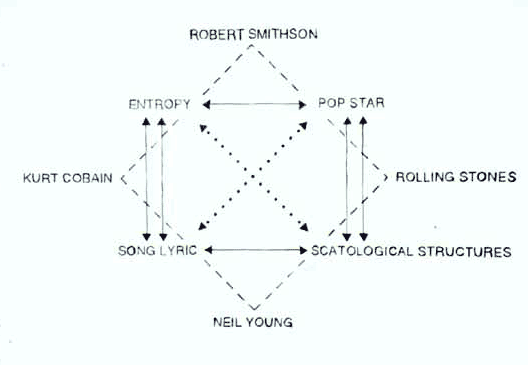Sam Durant: Quaternary Field/Associative Diagram

In a gesture dear to the heart of a modernist art historian, Durant's Quaternary Field/Associative Diagram, 1998... appropriates the structuralist Klein group diagram Krauss used to map the "expanded field of sculpture" in a canonical essay of 1978. In place of her oppositions of landscape and architecture, Durant introduces terms drawn from Smithson and pop music in order to locate the Earth artist, Kurt Cobain, the Rolling Stones, and Neil Young along axes of, for example, scatology and pop stardom. This is much more than clever parody. Durant is seriously, and I would say successfully, attempting to map the 'expanded field' appropriate to our own time—namely, 'visual culture,' which tries to articulate the complex relation between commercial aesthetics and the aesthetics of advanced art.
Sam Durant's works address utopias and their failures. They cross past events to create relationship between art-historical, pop- cultural, and political phenomena that have come to define popular, particularly American, culture during the last thirty- five years. Durant's conceptually conceived, multimedia installations refer to specific guiding figures and ideas; artist Robert Smithson and his work on entropic processes, rock stars Mick Jagger and Neil Young, as well as Black Panther co-founder Huey Newton, are in different ways integrated into his work. The enormous enthusiasm with which Durant's work has been received in Germany thus far is surprising on first sight, given his preoccupation with specifically American issues. However, when considered in relation to Andy Warhol, Robert Rauschenberg, Jasper Johns, Dennis Hopper, or Mike Kelley, Durant extends Germany's fascination with American art.
the impure thoughts of Sam Durant, from artforum:

In a gesture dear to the heart of a modernist art historian, Durant's Quaternary Field/Associative Diagram, 1998... appropriates the structuralist Klein group diagram Krauss used to map the "expanded field of sculpture" in a canonical essay of 1978. In place of her oppositions of landscape and architecture, Durant introduces terms drawn from Smithson and pop music in order to locate the Earth artist, Kurt Cobain, the Rolling Stones, and Neil Young along axes of, for example, scatology and pop stardom. This is much more than clever parody. Durant is seriously, and I would say successfully, attempting to map the 'expanded field' appropriate to our own time—namely, 'visual culture,' which tries to articulate the complex relation between commercial aesthetics and the aesthetics of advanced art.
Sam Durant's works address utopias and their failures. They cross past events to create relationship between art-historical, pop- cultural, and political phenomena that have come to define popular, particularly American, culture during the last thirty- five years. Durant's conceptually conceived, multimedia installations refer to specific guiding figures and ideas; artist Robert Smithson and his work on entropic processes, rock stars Mick Jagger and Neil Young, as well as Black Panther co-founder Huey Newton, are in different ways integrated into his work. The enormous enthusiasm with which Durant's work has been received in Germany thus far is surprising on first sight, given his preoccupation with specifically American issues. However, when considered in relation to Andy Warhol, Robert Rauschenberg, Jasper Johns, Dennis Hopper, or Mike Kelley, Durant extends Germany's fascination with American art.
the impure thoughts of Sam Durant, from artforum:

0 Comments:
Post a Comment
Subscribe to Post Comments [Atom]
<< Home